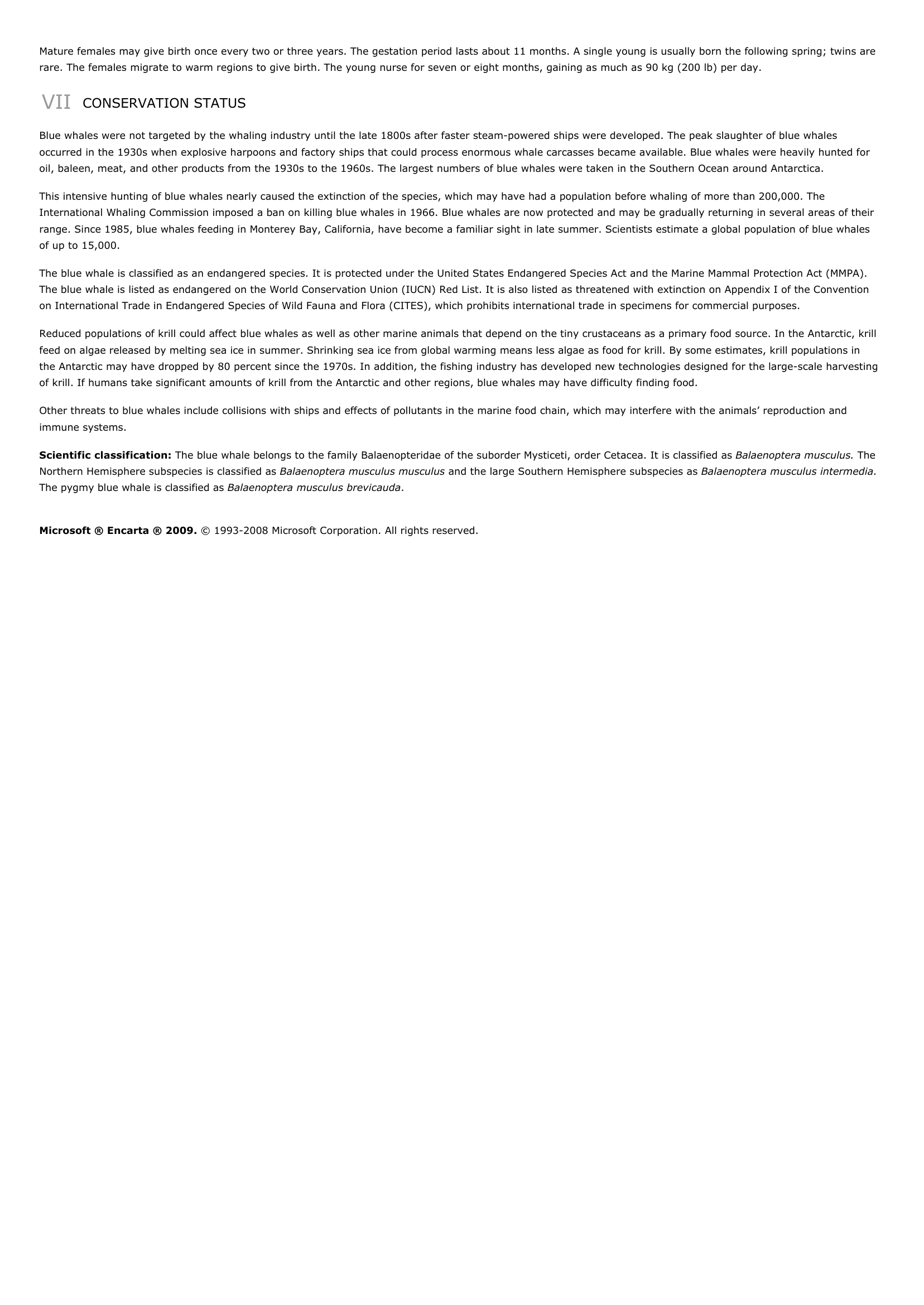Blue Whale - biology.
Publié le 11/05/2013
Extrait du document
«
Mature females may give birth once every two or three years.
The gestation period lasts about 11 months.
A single young is usually born the following spring; twins arerare.
The females migrate to warm regions to give birth.
The young nurse for seven or eight months, gaining as much as 90 kg (200 lb) per day.
VII CONSERVATION STATUS
Blue whales were not targeted by the whaling industry until the late 1800s after faster steam-powered ships were developed.
The peak slaughter of blue whalesoccurred in the 1930s when explosive harpoons and factory ships that could process enormous whale carcasses became available.
Blue whales were heavily hunted foroil, baleen, meat, and other products from the 1930s to the 1960s.
The largest numbers of blue whales were taken in the Southern Ocean around Antarctica.
This intensive hunting of blue whales nearly caused the extinction of the species, which may have had a population before whaling of more than 200,000.
TheInternational Whaling Commission imposed a ban on killing blue whales in 1966.
Blue whales are now protected and may be gradually returning in several areas of theirrange.
Since 1985, blue whales feeding in Monterey Bay, California, have become a familiar sight in late summer.
Scientists estimate a global population of blue whalesof up to 15,000.
The blue whale is classified as an endangered species.
It is protected under the United States Endangered Species Act and the Marine Mammal Protection Act (MMPA).The blue whale is listed as endangered on the World Conservation Union (IUCN) Red List.
It is also listed as threatened with extinction on Appendix I of the Conventionon International Trade in Endangered Species of Wild Fauna and Flora (CITES), which prohibits international trade in specimens for commercial purposes.
Reduced populations of krill could affect blue whales as well as other marine animals that depend on the tiny crustaceans as a primary food source.
In the Antarctic, krillfeed on algae released by melting sea ice in summer.
Shrinking sea ice from global warming means less algae as food for krill.
By some estimates, krill populations inthe Antarctic may have dropped by 80 percent since the 1970s.
In addition, the fishing industry has developed new technologies designed for the large-scale harvestingof krill.
If humans take significant amounts of krill from the Antarctic and other regions, blue whales may have difficulty finding food.
Other threats to blue whales include collisions with ships and effects of pollutants in the marine food chain, which may interfere with the animals’ reproduction andimmune systems.
Scientific classification: The blue whale belongs to the family Balaenopteridae of the suborder Mysticeti, order Cetacea.
It is classified as Balaenoptera musculus. The Northern Hemisphere subspecies is classified as Balaenoptera musculus musculus and the large Southern Hemisphere subspecies as Balaenoptera musculus intermedia. The pygmy blue whale is classified as Balaenoptera musculus brevicauda .
Microsoft ® Encarta ® 2009. © 1993-2008 Microsoft Corporation.
All rights reserved..
»
↓↓↓ APERÇU DU DOCUMENT ↓↓↓
Liens utiles
- Blue Whale.
- Whale Shark - biology.
- Killer Whale - biology.
- Whale - biology.
- La Rhapsody in Blue de Gershwin donne au jazz ses lettres de noblesse

































